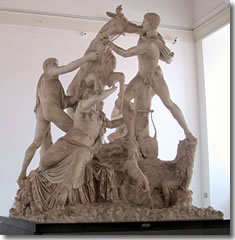This is one of the most significant archaeological collections in Europe (certainly Southern Italy's best), the only absolutely required sight in Naples, and well worth 2–3 hours of your time.
If you explore Pompeii without paying this museum a visit as well, you've missed out on half the riches. The best statues, mosaics, and wall paintings from Pompeii that could be carried off (and hadn't been already by looters) were long ago removed from the archaeological site to be preserved here.
The Pompeii riches take their place alongside finds from across Southern Italy as well as many from Rome itself (including the important and impressive statuary collected by the Farnese family).
The museum is poorly arranged and poorly labeled, but be sure to search out these highlights throughout the ill-lit rooms.

The Farnese Bull.The Doriforo, or Policleto's Spearman (a Pompeiian Roman copy of a 440 BC Greek original) is the most accurate surviving copy of a masterpiece by Policletus of Argo, one of the geniuses of Greek Golden Age sculpture. It represents Policletus' embodiment of the ideal human form, carved with exacting mathematical proportions and a perfect figurative balance.
The Pozzuoli Sarcophagus is a well-preserved AD 3rd-century Roman piece with a tumultuous high relief showing a seated, contemplative Prometheus creating Man surrounded by a swirl of gods and putti.
The massively burly Farnese Hercules was excavated from Rome's Baths of Caracalla and is a fine example of the exaggerated AD 3rd-century Athenian style of the sculptor Glykon.
Across the hall from it is the impressive Farnese Bull, also from the Baths of Caracalla, the largest surviving sculpture (13 feet tall) from the ancient world. It shows four figures struggling with a bull while a boy, a dog, and various flora and fauna sculpted into the base look on—all carved from a single, gargantuan block of marble. This AD 2nd-century Hellenistic work copies a 1st-century BC original and tells the tale of Amphion and Zethos (the two nude men) avenging the maltreatment of their mother Antiope (standing at the back) by tying her tormentor Dirke (the woman about to get trampled) to the horns of a bull she was preparing to sacrifice.
If you ever wondered what the famous Venus de Milo in Paris' Louvre looked like with arms, Naples' Aphrodite of Capua is the most faithful of many reproductions (the armless beauty in the Louvre is just the most famous) of a 6th-century BC original by Greece's greatest sculptor, Praxiteles.
Nearby is the even more alluring Torso of Psyche, this one without arms or legs but with a perfectly modeled and smoothly polished nude torso, also a Roman copy of a Hellenistic original.
On a mezzanine level between the ground and first floors (make sure you take the sweeping staircase on the left to gain access) is preserved the museum's most famous collection, the mosaics and paintings from Pompeii, including the slightly ruined but remarkably well-crafted Battle of Alexander and Darius, discovered in the House of the Faun at Pompeii.
This scene, with a highly advanced use of color and minuscule mosaic chips to render the figures as well as any painting, depicts the Battle of Isse of 333 BC, Alexander astride his horse (on the left) giving chase to Darius who's retreating in his chariot. It's probably a Roman copy of an original that was crafted within a few decades of the actual battle.
Among the paintings here, be sure you don't miss the portrait of a young woman wearing a gold filigree hair net and pausing with her stylus to her lips as she collects her thoughts before returning to write in the wax volume she holds.
This must have been a standard pose, for it appears again in the portrait of Paquio Proculo and his wife, a prosperous middle-class Pompeiian couple, probably bakers. This portrait was rather shocking when it was discovered, for it showed that interracial marriage was probably common (she appears to be European, he North African) in the ancient Empire.
The portrayal of these women is also intriguing in that it implies ancient Pompeii enjoyed a great deal of sexual as well as racial equality: the first is probably writing poetry (an artist), the second possibly keeping the books for the couple's bakery (a businesswoman).
Among the scads of fine bronze busts and statues of wrestlers and other athletes, you'll find the five oft-photographed Dancers of Herculaneum from that city's Villa of Papyrus. These five robed women, each striking a pose like a prototype for the Supremes or the Spice Girls, are early Roman bronzes done in the Greek style.
The collections are rounded out with Greek-era painted vases, engraved bronze pieces, a late–19th century model of Pompeii, and several elaborate gladiator's helmets found there.
Piazza Museo 19/Piazza Cavour (at the northern edge of the city)
tel. +39-081-442-2149 or +39-081-292-823
cir.campania.beniculturali.it
or
www.coopculture.it
Wed–Mon 9am–7:30pm
€12
Bus: 2M, 178, 460, C47, C63, N3, N4, N8, R1, R4
Hop-on/hop-off: Museo Archeoloico, Bellini (A)
Planning your day: Figure on spending at least 2–3 hours here—plus another 20–30 minutes each way just to get there, as it's a bit out of the center.
Share this page
Search ReidsItaly.com
Piazza Museo 19/Piazza Cavour (at the northern edge of the city)
tel. +39-081-442-2149 or +39-081-292-823
cir.campania.beniculturali.it
or
www.coopculture.it
Wed–Mon 9am–7:30pm
€12
Bus: 2M, 178, 460, C47, C63, N3, N4, N8, R1, R4
Hop-on/hop-off: Museo Archeoloico, Bellini (A)